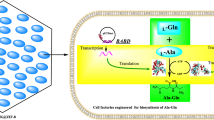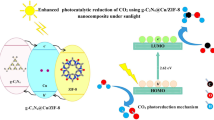Abstract
Carbonic anhydrase (CA) is a powerful biocatalyst for carbon dioxide (CO2) mineralization, of which immobilization is usually used for maintaining its catalytic activity against harsh external stimuli. However, the incorporated materials for CA immobilization would commonly increase the internal diffusion resistance during the catalytic process, thereby decreasing the catalytic efficiency. In our study, poly-l-glutamic acid (PLGA) as the structure regulator was used to induce the synthesis of CA@zeolitic imidazolate framework-8 (CA@ZIF-8) biohybrids. The introduction of PLGA that could coordinate with Zn2+ interfered the crystallization of ZIF-8, thereby changing the morphological structure of CA@ZIF-8 biohybrids. With the increase of PLGA amount from 0 to 60 mg, PLGA(x)-CA@ZIF-8 biohybrids were gradually transformed from a dodecahedron structure to a 3D lamellar nano-flower structure, which caused elevated exposed surface area. Accordingly, the loading ratio was increased from 34.6 to 49.8 mg gcat−1, while the catalytic activity was elevated from 20.6 to 23.4%. The CO2 conversion rate was enhanced by nearly two folds compared to PLGA(0)-CA@ZIF-8 under the optimized condition. The final CaCO3 yield could reach 5.6 mg mgcat−1, whereas the reaction system could remain above 80% of the initial reaction activity after 8 cycles.





Similar content being viewed by others
Data Availability
Not applicable.
References
Berg, I. A. (2011). Ecological aspects of the distribution of different autotrophic CO2 fixation pathways. Applied and Environment Microbiology, 77(6), 1925–1936.
Hermida-Carrera, C., Kapralov, M. V., & Galmes, J. (2016). Rubisco catalytic properties and temperature response in crops. Plant Physiology, 171(4), 2549–2561.
Verma, M., Bhaduri, G. A., Kumar, V. S. P., & Deshpande, P. A. (2021). Biomimetic catalysis of CO2 hydration: A materials perspective. Industrial and Engineering Chemistry Research, 60(13), 4777–4793.
Sheldon, R. A. (2012). Fundamentals of green chemistry: Efficiency in reaction design. Chemical Society Reviews, 41(4), 1437–1451.
Liang, S., Wu, X. L., Xiong, J., Zong, M. H., & Lou, W. Y. (2020). Metal-organic frameworks as novel matrices for efficient enzyme immobilization: An update review. Coordination Chemistry Reviews, 406, 213149.
Schmid, A., Dordick, J. S., Hauer, B., Kiener, A., Wubbolts, M., & Witholt, B. (2001). Industrial biocatalysis today and tomorrow. Nature, 409(6817), 258–268.
Behnood, A. (2019). Application of rejuvenators to improve the rheological and mechanical properties of asphalt binders and mixtures: A review. Journal of Cleaner Production, 231, 171–182.
Chiu, S. Y., Kao, C. Y., Chen, C. H., Kuan, T. C., Ong, S. C., & Lin, C. S. (2008). Reduction of CO2 by a high-density culture of Chlorella sp in a semicontinuous photobioreactor. Bioresource Technology, 99(9), 3389–3396.
Lian, X., Fang, Y., Joseph, E., Wang, Q., Li, J., Banerjee, S., Lollar, C., Wang, X., & Zhou, H. C. (2017). Enzyme-MOF (metal-organic framework) composites. Chemical Society Reviews, 46(11), 3386–3401.
Illanes, A., Cauerhff, A., Wilson, L., & Castro, G. R. (2012). Recent trends in biocatalysis engineering. Bioresource Technology, 115, 48–57.
Zhong, X., Xia, H., Huang, W. Q., Li, Z. X., & Jiang, Y. B. (2020). Biomimetic metal-organic frameworks mediated hybrid multi-enzyme mimic for tandem catalysis. Chemical Engineering Journal, 381(9), 122758.
Wang, W., Wen, P., Xu, K., Zheng, R., & Zheng, Y. (2019). Catalysis of enzymes under industrial environment and their adaptive modifications: A review. Sheng Wu Gong Cheng Xue Bao, 35(10), 1857–1869.
Thangaraj, B., & Solomon, P. R. (2019). Immobilization of lipases - A review Part I: Enzyme Immobilization. ChemBioEng Reviews, 6(5), 157–166.
Nguyen, H. H., & Kim, M. (2017). An overview of techniques in enzyme immobilization. Applied Science and Convergence Technology, 26(6), 157–163.
Zhang, B., Weng, Y., Xu, H., & Mao, Z. (2012). Enzyme immobilization for biodiesel production. Applied Microbiology and Biotechnology, 93(1), 61–70.
Bernal, C., Rodriguez, K., & Martinez, R. (2018). Integrating enzyme immobilization and protein engineering: An alternative path for the development of novel and improved industrial biocatalysts. Biotechnology Advances, 36(5), 1470–1480.
Xu, K. L., Chen, X. X., Zheng, R. C., & Zheng, Y. G. (2020). Immobilization of multi-enzymes on support materials for efficient biocatalysis. Frontiers in Bioengineering and Biotechnology, 8(17), 660.
Hwang, E. T., & Lee, S. (2019). Multienzymatic cascade reactions via enzyme complex by immobilization. ACS Catalysis, 9(5), 4402–4425.
Hernandez, K., & Fernandez-Lafuente, R. (2011). Control of protein immobilization: Coupling immobilization and site-directed mutagenesis to improve biocatalyst or biosensor performance. Enyzme and Microbial Technology, 48(2), 107–122.
Cao, Y., Li, X., & Ge, J. (2021). Enzyme catalyst engineering toward the integration of biocatalysis and chemocatalysis. Trends in Biotechnology, 39(11), 1173–1183.
Li, X., Cao, Y., Luo, K., Zhang, L., Bai, Y., Xiong, J., Zare, R. N., & Ge, J. (2022). Cooperative catalysis by a single-atom enzyme-metal complex. Nature Communications, 13(1), 2189.
Mohamad, N. R., Marzuki, N. H. C., Buang, N. A., Huyop, F., & Wahab, R. A. (2015). An overview of technologies for immobilization of enzymes and surface analysis techniques for immobilized enzymes. Biotechnology and Biotechnological Equipment, 29(2), 205–220.
Liu, D. M., Chen, J., & Shi, Y. P. (2018). Advances on methods and easy separated support materials for enzymes immobilization. Trac-Trends in Analytical Chemistry, 102, 332–342.
Meng, J., Liu, X., Niu, C., Pang, Q., Li, J., Liu, F., Liu, Z., & Mai, L. (2020). Advances in metal-organic framework coatings: Versatile synthesis and broad applications. Chemical Society Reviews, 49(10), 3142–3186.
Konnerth, H., Matsagar, B. M., Chen, S. S., Prechtl, M. H. G., Shieh, F. K., & Wu, K. C. W. (2020). Metal-organic framework (MOF)-derived catalysts for fine chemical production. Coordination Chemistry Reviews, 416, 213319.
Drout, R. J., Robison, L., & Farha, O. K. (2019). Catalytic applications of enzymes encapsulated in metal-organic frameworks. Coordination Chemistry Reviews, 381, 151–160.
Majewski, M. B., Howarth, A. J., Li, P., Wasielewski, M. R., Hupp, J. T., & Farha, O. K. (2017). Enzyme encapsulation in metal-organic frameworks for applications in catalysis. CrystEngComm, 19(29), 4082–4091.
Sun, Y., Shi, J., Zhang, S., Wu, Y., Mei, S., Qian, W., & Jiang, Z. (2019). Hierarchically porous and water-tolerant metal-organic frameworks for enzyme encapsulation. Industrial and Engineering Chemistry Research, 58(28), 12835–12844.
Liang, J., Gao, S., Liu, J., Zulkifli, M. Y. B., Xu, J., Scott, J., Chen, V., Shi, J., Rawal, A., & Liang, K. (2021). Hierarchically porous biocatalytic MOF microreactor as a versatile platform towards enhanced multienzyme and cofactor-dependent biocatalysis. Angewandte Chemie International Edition, 60(10), 5421–5428.
Hu, Z., Deibert, B. J., & Li, J. (2014). Luminescent metal-organic frameworks for chemical sensing and explosive detection. Chemical Society Reviews, 43(16), 5815–5840.
Li, J. R., Yu, J., Lu, W., Sun, L. B., Sculley, J., Balbuena, P. B., & Zhou, H. C. (2013). Porous materials with pre-designed single-molecule traps for CO2 selective adsorption. Nature Communications, 4, 1538.
Deng, J., Wang, K., Wang, M., Yu, P., & Mao, L. (2017). Mitochondria targeted nanoscale zeolitic imidazole framework-90 for ATP imaging in live cells. Journal of the American Chemical Society, 139(16), 5877–5882.
Huang, S., Kou, X., Shen, J., Chen, G., & Ouyang, G. F. (2020). “Armor-plating” enzymes with metal-organic frameworks (MOFs). Angewandte Chemie International Edition, 59(23), 8786–8798.
Sher, H., Ali, H., Rashid, M. H., Iftikhar, F., Saif-Ur, R., Nawaz, M. S., & Khan, W. S. (2019). Enzyme immobilization on metal-organic framework (MOF): Effects on thermostability and function. Protein and Peptide Letters, 26(9), 636–647.
Ye, N., Kou, X., Shen, J., Huang, S., Chen, G., & Ouyang, G. F. (2020). Metal-organic frameworks: A new platform for enzyme immobilization. ChemBioChem, 21(18), 2585–2590.
Liu, W. L., Yang, N. S., Chen, Y. T., Lirio, S., Wu, C. Y., Lin, C. H., & Huang, H. Y. (2015). Lipase-supported metal-organic framework bioreactor catalyzes warfarin synthesis. Chemistry--A European Journal, 21(1), 115–119.
Chen, L. Y., Luque, R., & Li, Y. W. (2017). Controllable design of tunable nanostructures inside metal-organic frameworks. Chemical Society Reviews, 46(15), 4614–4630.
Chen, G., Huang, S., Kou, X., Wei, S., Huang, S., Jiang, S., Shen, J., Zhu, F., & Ouyang, G. F. (2019). A convenient and versatile amino-acid-boosted biomimetic strategy for the nondestructive encapsulation of biomacromolecules within metal-organic frameworks. Angewandte Chemie International Edition, 58(5), 1463–1467.
Huang, S. M., Chen, G. S., Ye, N. R., Kou, X. X., Zhang, R., Shen, J., & Ouyang, G. F. (2020). Iron-mineralization-induced mesoporous metal-organic frameworks enable high-efficiency synergistic catalysis of natural/nanomimic enzymes. ACS Applied Materials & Interfaces, 12(51), 57343–57351.
Chen, G. S., Huang, S. M., Kou, X. X., Zhu, F., & Ouyang, G. F. (2020). Embedding functional biomacromolecules within peptide-directed metal-organic framework (MOF) nanoarchitectures enables activity enhancement. Angewandte Chemie International Edition, 59(33), 13947–13954.
Cai, G. R., & Jiang, H. L. (2017). A modulator-induced defect-formation strategy to hierarchically porous metal-organic frameworks with high stability. Angewandte Chemie International Edition, 56(2), 563–567.
Ren, G. Y., Dong, F. D., Zhao, Z. Q., Li, K., & Lin, Y. Q. (2021). Structure defect tuning of metal-organic frameworks as a nanozyme regulatory strategy for selective online electrochemical analysis of uric acid. ACS Applied Materials, 13(44), 52987–52997.
Li, L., Xiang, S. L., Cao, S. Q., Zhang, J. Y., Ouyang, G. F., Chen, L. P., & Su, C. Y. (2013). A synthetic route to ultralight hierarchically micro/mesoporous Al(III)-carboxylate metal-organic aerogels. Nature Communications, 4, 1774.
Hu, C., Bai, Y., Hou, M., Wang, Y., Wang, L., Cao, X., Chan, C. W., Sun, H., Li, W., Ge, J., & Ren, K. (2020). Defect-induced activity enhancement of enzyme-encapsulated metal-organic frameworks revealed in microfluidic gradient mixing synthesis. Science Advances, 6(5), 5785.
Tsuruoka, T., Furukawa, S., Takashima, Y., Yoshida, K., Isoda, S., & Kitagawa, S. (2009). Nanoporous nanorods fabricated by coordination modulation and oriented attachment growth. Angewandte Chemie International Edition, 48(26), 4739–4743.
Nicolas, P., Lassalle, V. L., & Ferreira, M. L. (2017). Quantification of immobilized Candida Antarctica lipase B (CALB) using ICP-AES combined with Bradford method. Enyzme and Microbial Technology, 97, 97–103.
Moorhead, D. L., & Weintraub, M. N. (2018). The evolution and application of the reverse Michaelis-Menten equation. Soil Biology & Biochemistry, 125, 261–262.
Chen, L., & Xu, Q. (2019). Metal-organic framework composites for catalysis. Matter, 1(1), 57–89.
Patel, R. N., Pandey, H. C., Pandeya, K. B., & Mukherjee, G. N. (1999). Mixed ligand complex formation of nickel(II), copper(II) and zinc(II) with some amino acids and imidazoles. Indian Journal of Chemistry Sect. A-Inorganic Bio-Inorganic Physical Theoritical & Analytical Chemistry, 38(8), 850–853.
Funding
This work was supported by the National Key R&D Program of China (2022YFC2105900, 2021YFC2102300), National Natural Science Fund of China (22122809), Natural Science Fund of Tianjin (19JCYBJC19700), Open Funding Project of the State Key Laboratory of Biochemical Engineering (2020KF-06) and Tianjin Synthetic Biotechnology Innovation Capacity Improvement Project (TSBICIP-KJGG-003) for financial support.
Author information
Authors and Affiliations
Contributions
Jiafu Shi, Zhuo Wang, and Yang Zhao contributed to the study conception and design. Formal analysis was finished by Yang Zhao, Zhuo Wang, Zhenhua Wu, Jiaxu Zhang, Boyu Zhang, Han Wang, and Zolfaghari Emameh Reza. Investigation, methodology, and data curation were performed by Zhuo Wang. Conceptualization, supervision, project administration, review, and editing were in charge of Jiafu Shi. The first draft of the manuscript was written by Zhuo Wang. All authors read and approved the final manuscript.
Corresponding author
Ethics declarations
Ethical Approval
Not applicable.
Consent to Participate
Not applicable.
Consent to Publish
Not applicable.
Conflict of Interest
The authors declare no competing interests.
Additional information
Publisher's Note
Springer Nature remains neutral with regard to jurisdictional claims in published maps and institutional affiliations.
Supplementary Information
Below is the link to the electronic supplementary material.
Rights and permissions
Springer Nature or its licensor (e.g. a society or other partner) holds exclusive rights to this article under a publishing agreement with the author(s) or other rightsholder(s); author self-archiving of the accepted manuscript version of this article is solely governed by the terms of such publishing agreement and applicable law.
About this article
Cite this article
Wang, Z., Zhao, Y., Wu, Z. et al. Hierarchically Structured CA@ZIF-8 Biohybrids for Carbon Dioxide Mineralization. Appl Biochem Biotechnol 195, 2829–2842 (2023). https://doi.org/10.1007/s12010-022-04250-7
Accepted:
Published:
Issue Date:
DOI: https://doi.org/10.1007/s12010-022-04250-7




